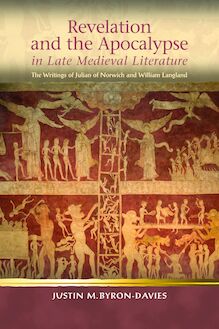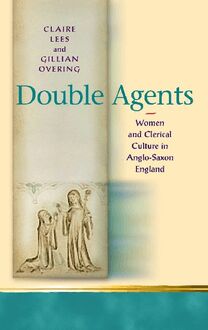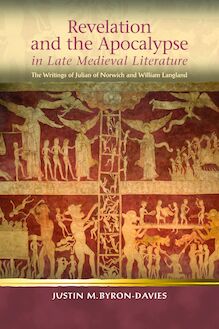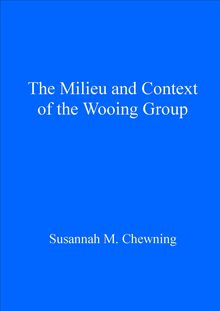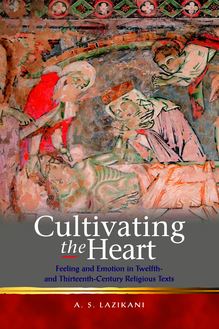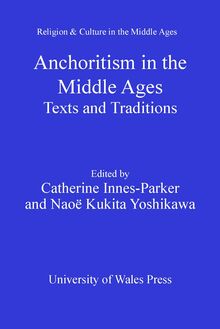Revelation and the Apocalypse in Late Medieval Literature , livre ebook
161
pages
English
Ebooks
2020
Vous pourrez modifier la taille du texte de cet ouvrage
Obtenez un accès à la bibliothèque pour le consulter en ligne En savoir plus
Découvre YouScribe en t'inscrivant gratuitement
Découvre YouScribe en t'inscrivant gratuitement
161
pages
English
Ebooks
2020
Vous pourrez modifier la taille du texte de cet ouvrage
Obtenez un accès à la bibliothèque pour le consulter en ligne En savoir plus
Publié par
Date de parution
01 février 2020
Nombre de lectures
1
EAN13
9781786835185
Langue
English
This interdisciplinary book breaks new ground by systematically examining ways in which two of the most important works of late medieval English literature – Julian of Norwich’s Revelations of Love and William Langland’s Piers Plowman – arose from engagement with the biblical Apocalypse and exegetical writings. The study contends that the exegetical approach to the Apocalypse is more extensive in Julian’s Revelations and more sophisticated in Langland’s Piers Plowman than previously thought, whether through a primary textual influence or a discernible Joachite influence. The author considers the implications of areas of confluence, which both writers reapply and emphasise – such as spiritual warfare and other salient thematic elements of the Apocalypse, gender issues, and Julian’s explications of her vision of the soul as city of Christ and all believers (the fulcrum of her eschatologically-focused Aristotelian and Augustinian influenced pneumatology). The liberal soteriology implicit in Julian’s ‘Parable of the Lord and the Servant’ is specifically explored in its Johannine and Scotistic Christological emphasis, the absent vision of hell, and the eschatological ‘grete dede’, vis-à-vis a possible critique of the prevalent hermeneutic.
Acknowledgements
Notes
Introduction
Chapter 1 - A Comparison of the Apocalypse and the Writings of Julian of Norwich
Chapter 2 - Orthodox and Heterodox Currents in the Writing of Julian of Norwich
Chapter 3 - Langland’s Poetics
Chapter 4 - Personification and Allegorisation in Piers Plowman
Conclusion
Selected Bibliography
Publié par
Date de parution
01 février 2020
Nombre de lectures
1
EAN13
9781786835185
Langue
English
RELIGION AND CULTURE IN THE MIDDLE AGES
Revelation and the Apocalypse in Late Medieval Literature
Series Editors
Denis Renevey (Université de Lausanne) Diane Watt (University of Surrey)
Editorial Board
Miri Rubin (Queen Mary University of London)
Jean-Claude Schmitt (École des Hautes Études en Sciences Sociales, Paris)
Fiona Somerset (Duke University)
Christiania Whitehead (University of Warwick)
RELIGION AND CULTURE IN THE MIDDLE AGES
Revelation and the Apocalypse in Late Medieval Literature
THE WRITINGS OF JULIAN OF NORWICH AND WILLIAM LANGLAND
JUSTIN M. BYRON-DAVIES
© Justin M. Byron-Davies, 2020
All rights reserved. No part of this book may be reproduced in any material form (including photocopying or storing it in any medium by electronic means and whether or not transiently or incidentally to some other use of this publication) without the written permission of the copyright owner except in accordance with the provisions of the Copyright, Designs and Patents Act. Applications for the copyright owner’s written permission to reproduce any part of this publication should be addressed to University of Wales Press, University Registry, King Edward VII Avenue, Cardiff CF10 3NS.
www.uwp.co.uk
British Library Cataloguing-in-Publication Data
A catalogue record for this book is available from the British Library.
ISBN 978-1-78683-516-1
e-ISBN 978-1-78683-518-5
The right of Justin M. Byron-Davies to be identified as author of this work has been asserted in accordance with sections 77 and 79 of the Copyright, Designs and Patents Act 1988.
The publisher has no responsibility for the persistence or accuracy of URLs for any external or third-party internet websites referred to in this book, and does not guarantee that any content on such websites is, or will remain, accurate or appropriate.
The cover image shows a detail from the twelfth-century wall painting in the church of St Peter and St Paul at Chaldon, Surrey, depicting the ways of salvation. By permission Keith Heron/Alamy. Cover design: Olwen Fowler
C ONTENTS
Series Editors’ Preface
Acknowledgements
Author’s Note
Introduction
1 A Comparison of the Apocalypse and the Writings of Julian of Norwich
2 Orthodox and Heterodox Currents in the Writing of Julian of Norwich
3 Langland’s Poetics
4 Personification and Allegorisation in Piers Plowman
Epilogue
Notes
Select Bibliography
S ERIES E DITORS ’ P REFACE
Religion and Culture in the Middle Ages aims to explore the interface between medieval religion and culture, with as broad an understanding of those terms as possible. It puts to the forefront studies which engage with works that significantly contributed to the shaping of medieval culture. However, it also gives attention to studies dealing with works that reflect and highlight aspects of medieval culture that have been neglected in the past by scholars of the medieval disciplines. For example, devotional works and the practice they infer illuminate our understanding of the medieval subject and its culture in remarkable ways, while studies of the material space designed and inhabited by medieval subjects yield new evidence on the period and the people who shaped it and lived in it. In the larger field of religion and culture, we also want to explore further the roles played by women as authors, readers and owners of books, thereby defining them more precisely as actors in the cultural field. The series as a whole investigates the European Middle Ages, from c .500 to c .1500. Our aim is to explore medieval religion and culture with the tools belonging to such disciplines as, among others, art history, philosophy, theology, history, musicology, the history of medicine, and literature. In particular, we would like to promote interdisciplinary studies, as we believe strongly that our modern understanding of the term applies fascinatingly well to a cultural period marked by a less tight confinement and categorization of its disciplines than the modern period. However, our only criterion is academic excellence, with the belief that the use of a large diversity of critical tools and theoretical approaches enables a deeper understanding of medieval culture. We want the series to reflect this diversity, as we believe that, as a collection of outstanding contributions, it offers a more subtle representation of a period that is marked by paradoxes and contradictions and which necessarily reflects diversity and difference, however difficult it may sometimes have proved for medieval culture to accept these notions.
A CKNOWLEDGEMENTS
My greatest debt of gratitude is owed to Professor Diane Watt. Having attended her lectures and seminars on medieval literature as an undergraduate at Aberystwyth University in the late 1990s and, a decade later, seminars on medieval women’s literature at Master’s level, I was delighted to embark on my doctoral research with her as my supervisor in the University of Surrey. With her calm, measured approach, Diane provided guidance when needed and offered constructive and cogent feedback on the various drafts of my work during those years. The successful completion of that endeavour laid the foundations for this monograph. She has been a continual source of encouragement and inspiration, and her erudite scholarship has provided a benchmark of excellence to which I aspire.
Special thanks are also due to Dr Alison Yeung whose invaluable advice some years ago enabled me to make my work more accessible to a broader readership and ensured that this book is more ‘reader friendly’ than it would otherwise have been. Around the same time, Dr David Ashford made a number of insightful comments in the course of a fruitful discussion on Langland’s poetics and I greatly appreciated his considered feedback.
It was a pleasure to work with the team at the University of Wales Press whose professional approach and expertise ensured that every stage in the preparation of this manuscript was completed as efficiently as possible. I am particularly grateful to Sarah Lewis who kept the project on course from its inception. She was swift to respond to queries and offered encouragement when there were unavoidable delays. In the late stages of the project Henry Mass brought his incisive approach as an editor to the manuscript, reading it with the utmost care. His keen eye for detail undoubtedly improved the work.
Finally, I would like to thank my parents for their enduring support and encouragement during the past decade.
A UTHOR’S N OTE
I have used the title Apocalypse as an alternative to the book of Revelation throughout, for two reasons. First, it is the direct translation from the original Greek ( Apokalypsis ). Second, this usage avoids possible confusion with Julian’s text.
Julian’s earlier text is referred to as A Vision or Vision and her later text as A Revelation or Revelation . When referring to material in both of these versions the inclusive title Revelations is adopted. When it is only a particular vision or multiple visions (not Julian’s reflections on the visions) to which I refer, ‘showing/s’ or simply ‘vision/s’ is used.
I NTRODUCTION
‘Thus by lawe,’ quod oure lord, ‘lede Y wol fro hennes Tho ledes that Y louye and leued in my comynge. Ac for the lesynge that thow low, Lucifer, til Eue Thow shal abyye bittere!’ quod god, and bonde hym with chaynes. 1
God shewed that the feend hath nowe the same malice that he had before the incarnation, and also sore he traveyleth, and as continually he seeth that all soules of salvation eskape him worshipfully, by the vertue of his precious passion. And that is his sorow, and full evil is he attemed, for all that God suffereth him to do turneth us to joy and him to shame and paine. And he hath as mekille sorow when God geveth him leve to werke as when he worketh not. And that is for he may never do as ille as he wolde, for his might is alle lokked in Gods hande. ( Revelation , 13, 7–14) 2
And so the Devil is bound throughout the whole period embraced by the Apocalypse, that is, from the first coming of Christ to the end of the world, which will be Christ’s Second Coming, and the meaning of the binding is not that he ceases to seduce the Church during that interval called ‘the thousand years’, as is shown by the fact that when unloosed he is evidently not destined to lead it astray. For assuredly if his binding meant that he is unable, or not allowed, to lead it astray, his unloosing can only mean that he is now able, or permitted, to do so. But God forbid that this should be the case! Instead, what the binding of the Devil means is that he is not permitted to exert his whole power of temptation either by force or by guile to seduce men to his side by violent compulsion or fraudulent delusion. For if he were permitted for so long a time, a time when so many were so insecure, he would overthrow very many of the faithful or prevent very many from believing, and those would be the kind of men to whom God did not will that this should happen. It was to prevent his achieving this that he was bound. 3
T hese quotations pertaining to the apocalyptic doctrine of the Harrowing of Hell exemplify the interplay between this eschatological event and these writers’ perceptions of the state of their milieux. I define the term eschatology not only as end times 4 events, or the last things, but also as historical events viewed within a Christocentric framework which claims prophetic foreknowledge of the final years of history, culminating in the Second Coming (parousia) and related events. From Christ’s legal justification for emancipating Sheol’s inhabitants from the devil’s charge in Passus XX of Piers Plowman , to Julian of Norwich’s view of sin as a punishment in itself, 5 and the devil as denuded of soul-incarcerating power, these writers expound a theological hermeneutic that addresses the good/evil dichotomy, contextualising it by considering its socio-religious implicati
